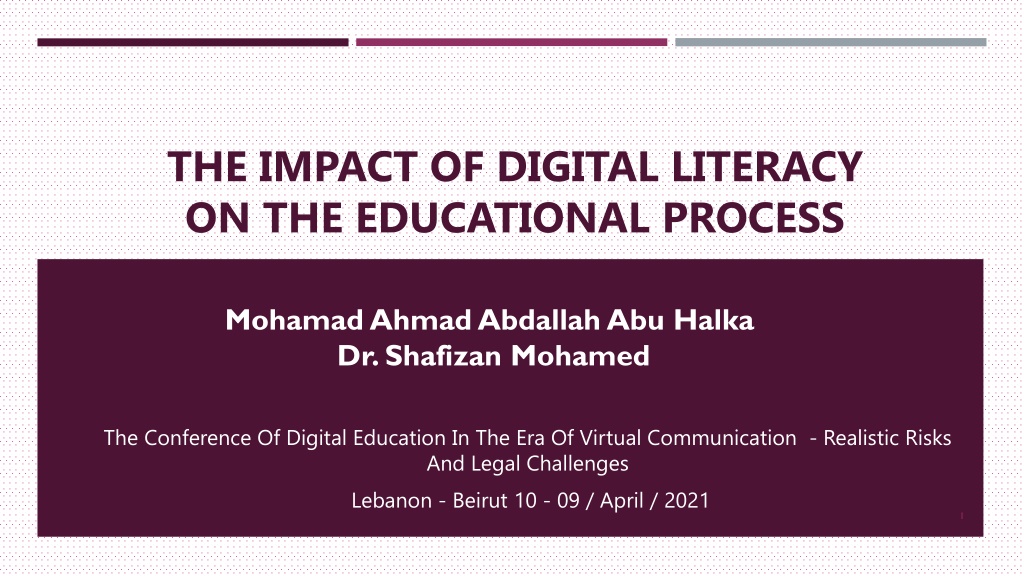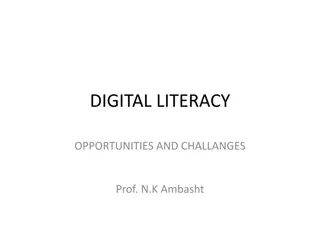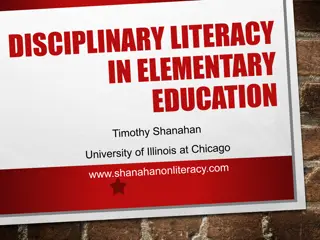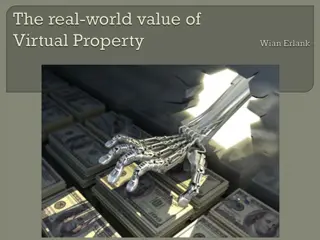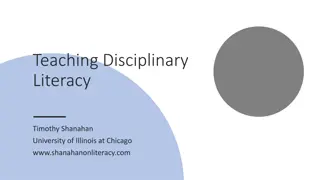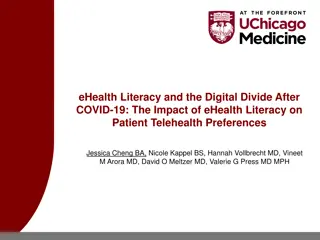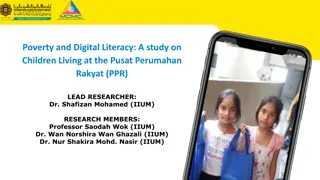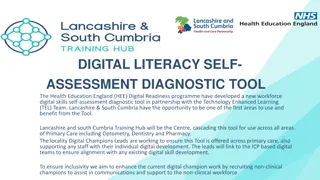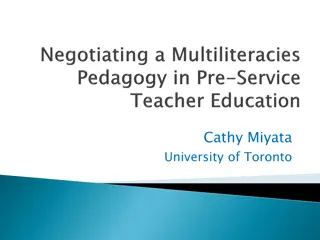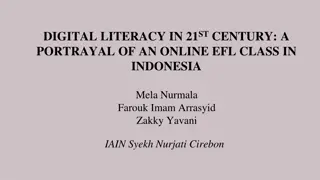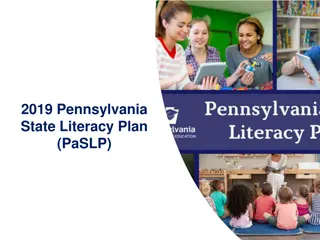The Impact of Digital Literacy on Education in the Era of Virtual Communication
The concept of digital literacy encompasses skills for using digital devices and technologies, evaluating digital content, and more. The educational process has been significantly influenced by digital technologies, leading to both positive impacts and challenges. The COVID-19 pandemic has accelerated the adoption of digital education, highlighting the importance of spreading digital literacy skills.
Uploaded on Sep 20, 2024 | 0 Views
Download Presentation

Please find below an Image/Link to download the presentation.
The content on the website is provided AS IS for your information and personal use only. It may not be sold, licensed, or shared on other websites without obtaining consent from the author. Download presentation by click this link. If you encounter any issues during the download, it is possible that the publisher has removed the file from their server.
E N D
Presentation Transcript
THE IMPACT OF DIGITAL LITERACY ON THE EDUCATIONAL PROCESS Mohamad Ahmad Abdallah Abu Halka Dr. Shafizan Mohamed The Conference Of Digital Education In The Era Of Virtual Communication - Realistic Risks And Legal Challenges Lebanon - Beirut 10 - 09 / April / 2021 1
THE IMPACT OF DIGITAL LITERACY ON THE EDUCATIONAL PROCESS Summary Problem of the study Objectives of the study Digital literacy models and methods of their application. Skills required to spread digital literacy. Difficulties and challenges faced in spreading digital literacy Conclusion References 2
SUMMARY The concept of digital literacyincluded multiple dimensions such as individuals having the skills necessary to reach a goal using digital devices and technologies, in addition to the trends and competencies in the use of these technologies, which are related to the ability to use computers, mobile phones, smart tablets, and access to social networks and the Internet. This concept goes beyond the idea of reaching awareness and consciousness of what is presented in the digital world to the evaluation of content and its creation, and this is what will be discussed in digital literacy skills 3
SUMMARY The educational process was not immune to digital technologies upon their emergence, as a feverish race began to invest these technologies and employ them in the educational process. Here, a difference emerged between those who saw that digital education positively affects the educational process, in contrast to those who saw that it consumes students' time and effort and diverts their attention from the basic learning path. It was also evident that there were difficulties and challenges for some in applying digital education to the educational process among the elements of the educational process (teacher-student - school as well as curricula) 4
SUMMARY All of this was in the pre-epidemic stage, I mean Covid 19, i.e. before February 2020, which constituted a milestone in the educational process, as digital education was at that time a thing of luxury up to the urgent need to spread this education with most students moving to distance learning or as Some called it e-learning 5
PROBLEM OF THE STUDY With the digital openness that humanity has reached, it was inevitable that individuals, including school students and teachers, possess skills that enable them to interact positively with this digital world and with what they are exposed to in terms of a huge amount of information and content as the teacher is no longer the source of knowledge as before, nor is the school curriculum the primary means To educate students, here the need arose to spread the culture of digital education so that the teacher and the learner could go through the educational process through a dynamic process. 6
PROBLEM OF THE STUDY Here, the problem of the study was manifested in the emergence of obstacles encountered in the educational process that resulted with the dissemination of digital education. Such as the gap between the levels of students and their teacher's ineffective dealing with the new digital life, in addition to the emergence of weak tools for some. 7
OBJECTIVES OF THE STUDY The study aimed to identify the importance of digital education and its effects on the educational process, and shed light on the obstacles that may face the use of digital education in educational institutions. In order to reach keeping up with reality in a way that can be described as correct, and to make use of digital tools through the skills and knowledge required by this age. 8
MODELS OF APPLYING DIGITAL EDUCATION IN THE EDUCATIONAL PROCESS Partial Model The Digital Model Mixed Model 9
PARTIAL MODEL Directing students to view digital resources through accredited websites with the intention of preparing in advance for lessons. Directing students to create simple research papers or projects through reliable digital resources. The teacher's use of digital means that support the knowledge to be explained to students, such as video, pictures, and various digital texts. The teacher's use of digital applications in order to make statements and tables to facilitate the saving and modification of students' data. Investing in some digital means to publish some details related to educational life. 10
MIXED MODEL Exchanging roles using a digital network that connects the parties to the educational process, where traditional classroom education is mixed with digital education, so students discuss with each other and their teacher through the digital network and exchange views to reach the desired goal. The teacher's role as organizer of the process, and the exchange of roles away from the indoctrination used in traditional education, where the teacher raises issues that are discussed using digital means. Combining the digital exams and the traditional class exams, and here the teacher can take the tests in two digital and traditional images. 11
THE DIGITAL MODEL This model has the advantage of transcending the limits of time and space, as there are no limits to the walls (the boundaries of the classroom or school) and no limit to time (the official working time of the school). In this model, the student does not need to go to school at all, but rather, he needs to enter the digital (virtual) classes, and their educational content is available throughout the whole day, and the teacher in these classes is a mentor only. The student or the learner is the main focus of the learning process because he is the one who determines and chooses how and when he wants to learn. 12
THE SKILLS REQUIRED TO BENEFIT FROM DIGITAL EDUCATION IN THE EDUCATIONAL PROCESS 1- The skill of accessing information 2- Information awareness skill 3- The skill of evaluating information 4- The skill of creating and creating information 13
DIFFICULTIES FACING DIGITAL EDUCATION INVESTMENT IN THE EDUCATIONAL PROCESS Difficulties related to the educational system 1- Barriers between different parties that affect the educational process 2- The unavailability of the required digital technology support and its keeping pace with what is global. 3- Digital education needs specialists in the fields of digital education systems who possess the knowledge and skills necessary to adapt digital tools to facilitate their use in the educational process. 4- The lack of secure digital gates in which the learners privacy can be preserved. 5- Lack of clarity in digital education systems and failure to convert paper- based curricula into interactive digital curricula. 6- The emergence of some technical and technical problems in digital devices and the problem of Internet speed. 14
DIFFICULTIES FACING DIGITAL EDUCATION INVESTMENT IN THE EDUCATIONAL PROCESS Difficulties associated with the teacher 1- The limited number of teachers who are proficient in digital skills and digital education in an effective manner. 2- The lack of adequate training for teachers to deal with digital education in the best possible way. 3- Lack of developing skills through daily training in order to improve the educational process. 15
DIFFICULTIES FACING DIGITAL EDUCATION INVESTMENT IN THE EDUCATIONAL PROCESS Difficulties Associated with the Learner (Student) 1- The great discrepancy in the level of students in digital education. 2- The presence of distractions that may distract students from education. 3- The problem of weakness of some learners and their difficulty in making use of digital tools. 4- The lack of appropriate training for students to deal with digital education in the best possible way. 16
FINDINGS AND RECOMMENDATIONS 1- Building specialized training programs in digital education that help teachers and students invest in the digital world to benefit from it in the educational process. 2- Building successful collective models and not being satisfied with individual efforts of institutions, each of them separately. 3- Emphasizing the importance of effective engagement with digital education and enhancing its role in front of government agencies 4- Addressing the weaknesses between all categories of the educational process and bridging the digital gap between learners and teachers 5- Providing and supporting digital tools to benefit from digital education 17
REFERENCES Darweesh, A. R. (2006). Moqademah fe elm aletisal. Damietta: https://library.alistiqlal .edu.ps/book-3002-en.html. Saleh, Ibrahim (2009), Media Literacy in MENA: Moving beyond the Vicious Cycle of Oxymora. In: Frau-Meigs, Divina and Torrent, Jordi (ED), Mapping Media Education Policies in the World: Visions, Programmes and Challenges. (pp. 155-174), New York, United Nations- Alliance of Civilizations Hobbs, R. (2010), Digital and media literacy: A plan of action. Washington, D.C.: The Aspen Institute Ashdiefat, A., & Khasawneh, K. (2012). The Factors Influencing Media Education in Private Schools in Jordan from Students Perspective. Jordan: https://platform. almanhal.com/GoogleScholar/Details/?ID=2-14433. Olimat, A. (2013). waqe istikhdam mualemi alolomlilmustahdathat altiqnologyah fe tadresehim be muhafathat almafraq. Almanarah for Research and Study. Retrieved from http://repository.aabu.edu.jo/jspui/handle/123456789/330 UNESCO. (2013). Integrating media and information literacy into Jordanian schools | United Nations Educational, Scientific and Cultural Organization. Amman. Retrieved from http://www.unesco.org/new/en/amman/about-this-office/single- view/news/integrating_media_and_information_literacy_into_jordanian_sc/ Melki, J. P. (2015), Guiding Digital and Media Literacy Development in Arab Curricula Through Understanding Media Uses of Arab Youth. Journal of Media Literacy Education, 6(3), 14-28 18
REFERENCES Assal.H (2016), Parents Knowledge of Media and Digital Literacy in The Jordanian Society. Master theses, Jordan Durra, Yasar (2016), A Jordanian Perspective. In: Abu-Fadil, Magda. Torrent, Jordi. and Grizzle, Alton (ED), Opportunities for Media and Information Literacy in The Middle East and North Africa. (pp: 115-124), Gothenburg, NORDICOM, University of Gothenburg. Melki, Jad and Maaliki, Lubna (2016), Helping Arab Digital and Media Literacy Blossom: Three Years of the Media and Digital Literacy Academy of Beirut (MDLAB). In: AbuFadil, Magda. Torrent, Jordi. and Grizzle, Alton (ED), Opportunities for Media and Information Literacy in The Middle East and North Africa. (pp: 41-47), Gothenburg, NORDICOM, University of Gothenburg. Tayie, Samy (2016), An Egyptian Perspective. In: Abu-Fadil, Magda. Torrent, Jordi. and Grizzle, Alton (ED), Opportunities for Media and Information Literacy in The Middle East and North Africa. (pp: 107-113), Gothenburg, NORDICOM, University of Gothenburg Jordan Statistical Department. (2017). Jordan StatisticalYearbook 2017 Department of Statistics. RetrievedAugust 3, 2019, from http://dosweb.dos.gov.jo/ products/ statistical_yearbook2017/ JMI. (2018). About Jordan media institute. Retrieved January 4, 2019, from http://www.jmi.edu.jo/en/content/39/About-JMI Media commission. (2019). Media commission. Retrieved January 31, 2019, from http://www.mc.gov.jo/Pages/viewpage?pageID=34 19
THANK YOU 20
